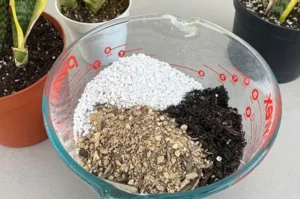Snake plants (Sansevieria), known for their resilience, can still suffer from cold damage, especially when exposed to freezing temperatures. If your snake plant has been caught in frost or freezing weather, don’t worry! There’s a good chance you can revive it with the right care. In this article, we’ll guide you through the steps to help your frozen snake plant recover and how to protect it in the future.
How Cold Affects Snake Plants
Snake plants are native to warmer climates and do not tolerate freezing conditions. When exposed to temperatures below 50°F (10°C), the plant starts to stress. At freezing temperatures (32°F or 0°C), the water inside the leaves and roots can freeze, causing cells to burst. This leads to mushy, brown, or black leaves — common signs of cold damage.
Signs Your Snake Plant is Frozen
Before you begin the recovery process, check for signs of frost damage. Some common symptoms include:
- Soft or mushy leaves
- Black or brown spots on the leaves
- Leaves that are drooping or curling
- Discoloration, especially near the base of the leaves
- A foul smell from rotting parts
Step-by-Step Guide to Revive a Frozen Snake Plant
1. Move the Plant to a Warm Location
The first and most important step is to bring the plant indoors or to a warmer space. Choose a spot with indirect sunlight and a temperature between 60°F–75°F (15°C–24°C). Avoid placing it near heaters or vents, as sudden temperature changes can cause more stress.
2. Let the Plant Thaw Slowly
Allow your plant to naturally return to room temperature. Do not attempt to warm it with a blow dryer or heating pad — this can worsen the damage.
3. Hold Off on Watering
Do not water a frozen snake plant immediately. The roots are already stressed, and watering can cause rot. Wait at least a week, then check the soil. Only water when the top 2–3 inches of soil are completely dry.
4. Trim Damaged Leaves
After a few days in a warm environment, inspect the leaves. Using sterilized scissors or pruning shears, cut away any mushy, discolored, or rotting leaves. This prevents the spread of rot and helps the plant focus energy on healthy growth.
- Cut the leaf at the base if the entire leaf is damaged.
- If only the tip is affected, you can trim just the top part.
5. Check the Roots
Gently remove the plant from its pot and inspect the roots. Healthy roots are white or light tan and firm. Black, mushy, or foul-smelling roots are dead and should be removed.
- Use clean scissors to cut off damaged roots.
- Let the plant air dry for a few hours before replanting in fresh, dry soil.
6. Repot with Well-Draining Soil
Once the damaged parts are removed, repot the plant in fresh, dry, well-draining cactus or succulent soil. Make sure the pot has good drainage holes to prevent water buildup.
7. Resume Normal Care
After repotting:
- Place the plant in bright, indirect light.
- Water only when the soil is dry.
- Avoid fertilizing until the plant shows signs of new growth.
Recovery may take a few weeks to a few months depending on the severity of the freeze.
How to Prevent Future Freezing
Prevention is always better than cure. Here are some tips to protect your snake plant from freezing:
- Bring it indoors during cold months (especially when temperatures drop below 50°F).
- Avoid placing it near drafty windows or cold floors.
- Use insulated pots if you must keep it outside during cool nights.
- Move the plant away from unheated areas like garages or porches during winter.
Frequently Asked Questions (FAQs):
Can a snake plant survive after freezing?
Yes, if the core of the plant and the roots are still healthy, a frozen snake plant can recover. However, severely damaged plants may not survive if rot has spread deeply.
How long does it take for a snake plant to recover from freezing?
Depending on the damage, recovery can take anywhere from a few weeks to several months. Be patient and consistent with care.
Should I fertilize my snake plant after it freezes?
No, avoid fertilizing a stressed or frozen snake plant. Wait until it starts producing new leaves before resuming a light fertilizer routine.
Can I propagate from the healthy parts of a frozen snake plant?
Yes, if some leaves are still firm and green, you can cut them and use them for propagation in water or soil.






